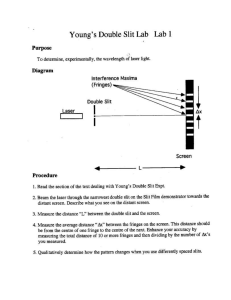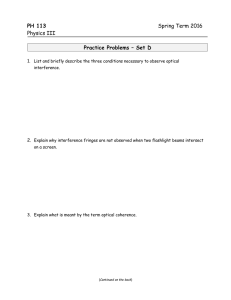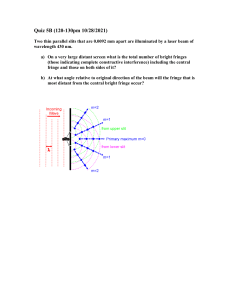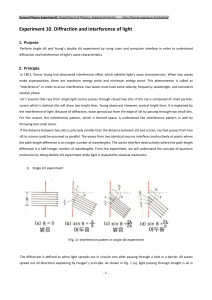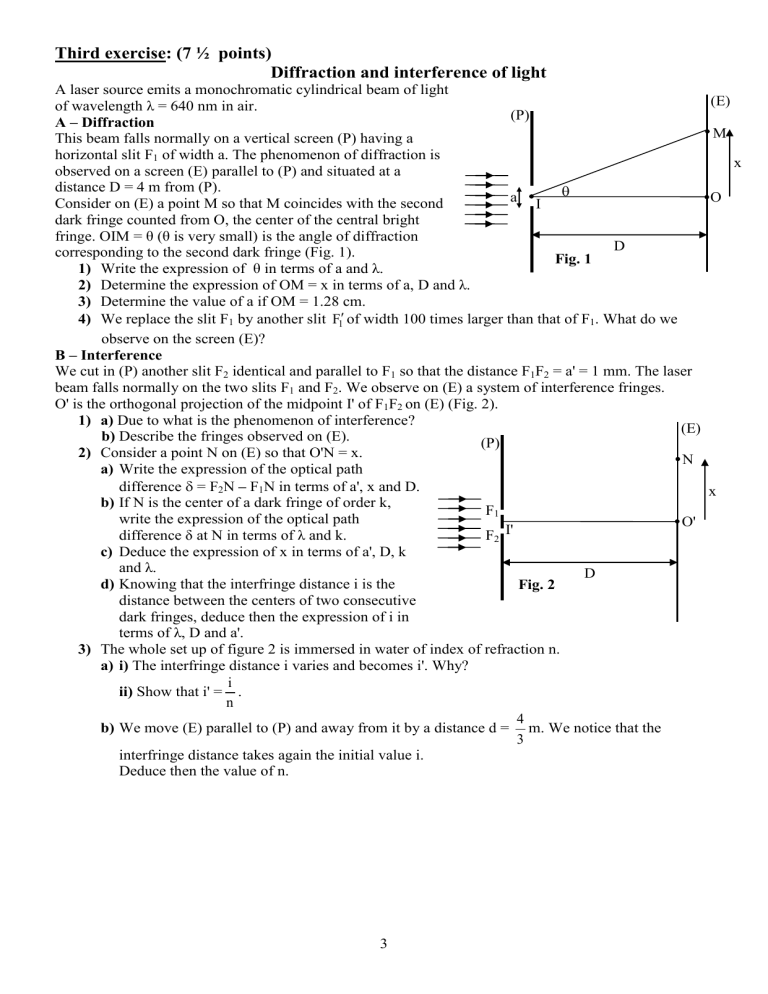
Third exercise: (7 ½ points) Diffraction and interference of light A laser source emits a monochromatic cylindrical beam of light . (P) A Diffraction This beam falls normally on a vertical screen (P) having a horizontal slit F1 of width a. The phenomenon of diffraction is observed on a screen (E) parallel to (P) and situated at a distance D = 4 m from (P). a I Consider on (E) a point M so that M coincides with the second dark fringe counted from O, the center of the central bright fringe. OIM = ( is very small) is the angle of diffraction D corresponding to the second dark fringe (Fig. 1). Fig. 1 1) Write the expression of 2) Determine the expression of . 3) Determine the value of a if OM = 1.28 cm. 4) We replace the slit F1 by another slit F1 of width 100 times larger than that of F1. What do we observe on the screen (E)? B Interference We cut in (P) another slit F2 identical and parallel to F1 so that the distance F1F2 = a' = 1 mm. The laser beam falls normally on the two slits F1 and F2. We observe on (E) a system of interference fringes. O' is the orthogonal projection of the midpoint I' of F1F2 on (E) (Fig. 2). 1) a) Due to what is the phenomenon of interference? (E) b) Describe the fringes observed on (E). (P) 2) Consider a point N on (E) so that O'N = x. N a) Write the expression of the optical path difference = F2N F1N in terms of a', x and D. b) If N is the center of a dark fringe of order k, F1 write the expression of the optical path O' difference at N in terms of and k. F2 I' c) Deduce the expression of x in terms of a', D, k and . D d) Knowing that the interfringe distance i is the Fig. 2 distance between the centers of two consecutive dark fringes, deduce then the expression of i in terms 3) The whole set up of figure 2 is immersed in water of index of refraction n. a) i) The interfringe distance i varies and becomes i'. Why? i ii) Show that i' = . n 4 b) We move (E) parallel to (P) and away from it by a distance d = m. We notice that the 3 interfringe distance takes again the initial value i. Deduce then the value of n. 3 (E) M x O x Third exercise: Diffraction and interference of light Part of the Q 7½ Answer A.1 M is a dark fring A.2 tan A.3 a n OM D 2 D x Mark 2 a x then x = OM D D 1 a ¾ 2D a ¾ 0.4mm We observe a spot of light. ½ It is due to the superposition of 2 luminous radiations. ½ bright and dark fringes. parallel , rectilinear and equidistant ½ A.4 B.1.a B.1.b a 'x D B.2.a B.2.b ¼ D 2a ' B.2.c x = (2k+1) B.2.d i = xk+1 xk = B.3.a.i i= B.3.a.ii B.3.b ¼ 2 ½ D a' ½ D and varies because the speed of light varies, a v c and v ; n n D D i i' = a na n D' = D + d ; i = (D d) na D a (D d) D n 3 n i varies. D d 1.33 D ½ ¾ ¾

